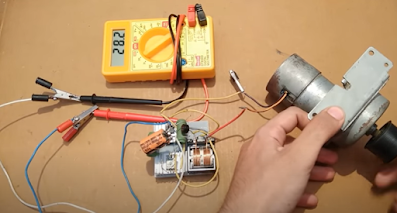How to Improve Generator Voltage Updated 2021 | Free Article Spinner.
In this article, we’ll explore how a handmade boost circuit can amplify the output of a low-RPM, 20V DC generator, which is commonly used in small wind turbines. This test aims to demonstrate how this circuit can help maximize voltage output even at low rotation speeds, potentially making it ideal for low-wind conditions.
Circuit Setup
The generator in use is rated for 20 volts DC and operates at a low RPM. The output terminals of the generator are connected to the input terminals of the boost circuit, with the final output terminals connected to a multimeter set to measure DC voltage up to 200 volts. This setup allows us to observe any increase in voltage achieved through the circuit.
Testing the Generator with the Boost Circuit
Upon turning the generator shaft, the multimeter immediately shows a generated voltage. Interestingly, even when the shaft stops rotating, the multimeter continues to display a voltage reading. This is due to the capacitor connected to the circuit, which stores the generated charge, preventing the reading from dropping to zero.
As I increase the speed of the shaft rotation, the multimeter shows a corresponding increase in voltage. The circuit can handle a wide input voltage range, from as low as 1 volt up to 32 volts, making it adaptable to various wind speeds. During testing, the maximum voltage achieved with manual rotation using the boost circuit was 50.6 volts DC.
Testing Without the Boost Circuit
To understand the impact of the boost circuit, I tested the generator again, but this time without the circuit. The maximum voltage achieved through manual rotation was 14.2 volts DC—significantly lower than the 50.6 volts achieved with the boost circuit. This demonstrates how the circuit amplifies the generator’s voltage output by over three times, which could be very useful in low-wind conditions.
Addressing Current and Voltage Trade-Offs
Some may argue that boosting the voltage will decrease the current, given the principle that power is constant. While this is true, the circuit’s purpose is to make low generated voltages usable when wind speeds are too low to reach the generator's rated output. Rather than relying on a massive generator that generates high amperage but fails to reach sufficient voltage to power a load, this circuit boosts the output voltage to a level that can be more practically used, even if it means operating at lower power.
Practical Applications in Low-Wind Conditions
In low wind conditions, where the generated voltage might be insufficient, this boost circuit enables you to amplify that voltage, allowing for some level of power generation and utilization. When wind speed increases to the point where the generator naturally produces the required voltage (e.g., 12V or 24V), the circuit can then switch to direct generation mode to utilize the maximum available current directly.
This boost circuit test demonstrates a valuable approach to increasing efficiency in low-wind situations by making the most of lower generated voltages.
As demonstrated, when the boost circuit is connected to the generator, it performs well even at low RPM, successfully powering LED strips. However, without the circuit, the generator fails to produce enough voltage at the same RPM to light the LEDs. This shows that at low rotational speeds, the voltage generated is insufficient to power most appliances directly.
How the Boost Circuit Improves Usability
When the generator operates at low RPM, it naturally produces lower voltage, often inadequate for running devices. By connecting a boost circuit, we can amplify this low voltage, making it suitable for operating appliances or lights even in minimal wind conditions. This simple enhancement turns otherwise unusable low-speed output into functional, usable power.
Alternative: Adding a Gearbox
An alternative to the boost circuit is to connect an additional gearbox, which could increase the generator’s speed and generate a stable 12V or 24V output. However, turning the generator shaft manually or with minimal wind becomes much more challenging when a gearbox is involved due to the increased resistance.
In summary, for low wind scenarios or slow RPMs, using a boost circuit can be a practical solution to make low-voltage output usable. Adding a gearbox is another option, but it can make manual rotation or low-wind operation difficult due to the increased torque required.





0 comments:
Post a Comment